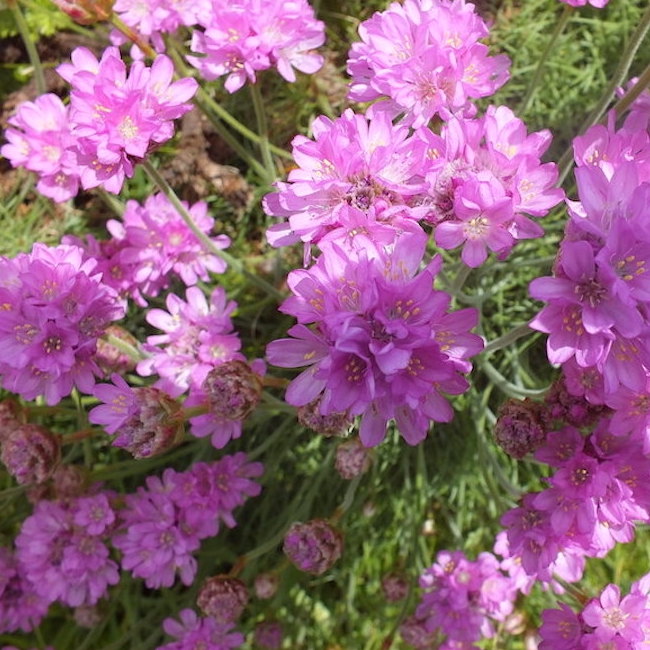
The lollipop heads of Thrift start to bloom in April, all pink and gorgeous on the clifftops.
Photo: Amanda Scott
Scientific name: Armeria maritima ssp. maritima
Other common names: Sea Pink, Rock Rose, Ladies’ Cushions, Cliff Clover
Cornish name: Britton
What to look for:
- Family: Plumbaginaceae (Sea-lavender family)
- Flowers : Usually pink, sometimes white, flowers are clustered in round heads. The small individual flowers are five-petalled, approximately 8 mm in width.
- Leaves and stem : Rosettes of narrow leaves. The flower stems are downy.
- Height : Flower stems up to 30 cm.
- Where : Mainly coastal: cliff tops, shingle and salt marshes. It can also be found inland on mountain ledges.
- When : The flowers can be seen from April into the early autumn, though the main flowering period is April until July.
- Habit : Upright.

From a distance they might look like hundreds and thousands of little pink lollipops stuck into the soils of the cliff tops, but they are, of course, the familiar but ever-beautiful flowers of Thrift. Also known, for obvious reasons, as Sea Pinks, they begin to brighten coastal walks from April, with flowers that can last into the early autumn. Thrift’s habit of growing in long swathes gives it its Gaelic name of tonna chladaich, which means beach wave.
It may look delicate, but Thrift is a resilient little plant. Its coastal habitat means that it is tolerant of salt and drying winds. Indeed, it is occasionally but increasingly found inland next to roads that have been treated with salt. It’s a popular garden plant, as well, and has been so since the sixteenth century. The linear tufts of leaves have evolved to protect against water loss, making it a great plant for a dry sunny spot in the borders.
Look out for the colour variations. Some plants have white flowers, and even among the more common pink flowers there are many different hues.
Did you know…?
…Thrifty: the older generations among us may remember that the British threepence coin displayed the Thrift on its reverse between 1937 and 1952.
…Thrift is tolerant of metalliferous soils, so can sometimes be found growing round old mine spoil heaps.
More information and references:
Mabey, R., 1997. Flora Britannica. Chatto & Windus, London.
Rose, F. and O’Reilly, C., 2006. The Wild Flower Key, 2nd edition. Frederick Warne, London.
Stace, C., 2010. New Flora of the British Isles, 3rd edition. Cambridge University Press, Cambridge.
Published: April 2015
Author: Amanda Scott
Photos: Amanda Scott
